Inniscrone Golf Club
Pennsylvania, United States of America
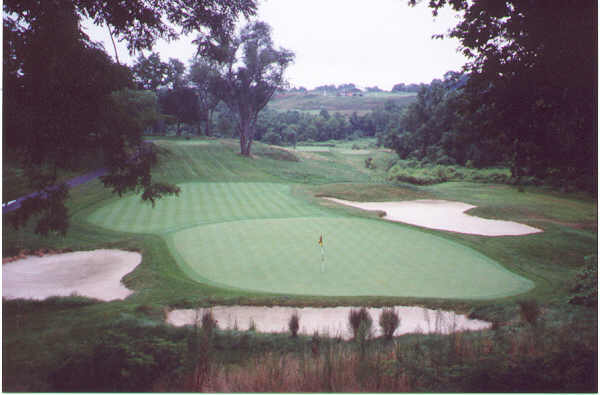
This view from behind the one-shot 11th typifies Inniscrone’s rugged character.
Philadelphia is the United States’ answer to Melbourne and London, boasting more than its share of top-notch golf while at the same time having its own brand of architecture. While each city has its dominant architect (Melbourne – Alister MacKenzie; London – Harry Colt; Philadelphia – William Flynn), the land melds together the work of different designers. The Sand Belt of Melbourne has the recurring theme of some of the world’s best bunkering; London features heathland golf replete with pines, heather, and old-fashioned bunkering. While the William Flynn gems of Huntingdon Valley, Philadelphia Country Club, and Rolling Green possess these attributes in spades, so do the non-Flynn courses such as Aronimink.
However, no significant course was built in the Philadelphia area from World War II until the early 1990s. The better land was already occupied by golf courses, and the real estate prices were, appropriately, those of a major eastern metropolis. Those wishing to build something new were forced to look west and/or south for more reasonable farmland. As a result, the character of the new courses could not help but be different. First, there was Stonewall, some 40 miles west and north of the city, built in the early 1990s. Here, Tom Doak and Gil Hanse inherited Tom Fazio’s routing over an awkward piece of land with environmental concerns. Thanks to some of the best greens built in the past 60 years, the course is a success. One wonders if the architects were paying homage to the traditional Philly work as, like Huntingdon Valley, almost every green has a clear high side to which the player does not want to miss the green.
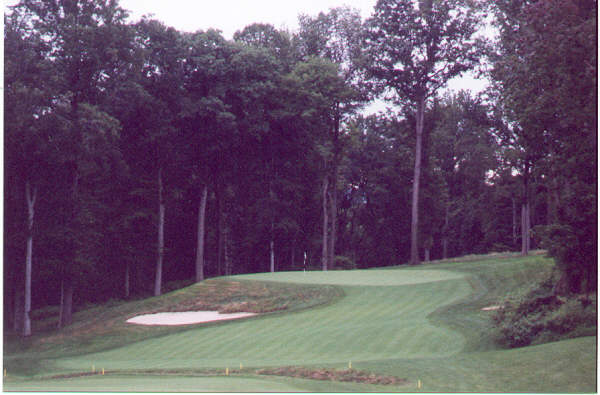
The approach to the 4th, with everything feeding to the back-left part of the green.
Several years later, Gil Hanse, now teaming with former Merion professional Bill Kittleman, had another similar opportunity, this one some 40 miles south and west of Philadelphia. As at Stonewall, the site was far from ideal, with some severe elevation changes, a public road almost bisecting the property, and, again, some environmental restrictions. How, then, could Hanse build a course that would appeal to the traditionalists of Philadelphia (as well as nearby Wilmington, Delaware), from where the club would draw its members?
First, Hanse got the details right – from the varied greens to the traditional bunkers full of character (the latter being largely the work of Kittleman). Second, he gave the members a bold course; no one walks up to a hole at Inniscrone and sighs ‘Great. Hole #43B from the design drawer. Yawn.’ Third, he simply designed and built a slew of arresting holes, as seen below.

Neither the bunkers nor their rakes should be taken lightly at Inniscrone.
Holes to Note
Second hole, 360 yards; A hole whose simple strategy seems so foreign these days. From the tee, a gentle upslope crests less than 200 yards away, allowing the player to see only the beginnings of a formidable bunker down the right and a split-rail fence down the left. The first round or two he plays here, the player will likely play toward the bunker, feeling more comfortable in a hazard he can see than playing toward the unknown down the left. However, as the player plays the hole more often, he quickly comes to realize there is plenty of room to the left, past the fence, to hold the missed tee shot. So now he will favor the left side the next several times he plays the hole, until it sinks in that the left side offers a most undesirable angle of approach, with the large bunker guarding the left of the green and the green’s left-to-right slope. Even though the approach is just a pitch, the slope of the green is enough to ensure that a player in the left rough can hope for nothing better than the finishing on the right edge of the green. So now, with his next round, he is back to square one, challenging the wonderful bunker complex down the right. What an ideal hole for one’s home course. 3rd hole, 315 yards: The most visually appealing hole on the course, the 3rd again requires much thought from the tee, although this time everything is in full view. The fairway bunker on the left forces the player to decide whether to play short, right or past of the bunker. The hole location can affect the play, as the farther right the player drives, the more he is looking down the length of the green which, to the amazement of many, actually runs away from the player.
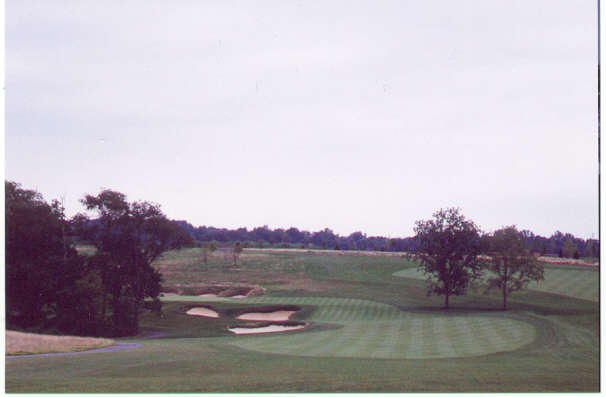
The strategic tee shot on the short 3rd.
Sixth hole, 445 yards; A gentle uphill hole that leads to the authors’ favorite green complex on the course, with its left to right tilt and ample room on the left to bounce in the long approach. The other interesting feature is a tree branch that overhangs the right side of he fairway some 150 yards from the green. The player who is on the right side of the fairway may be bothered by the branch, but in reality few long or mid-iron approaches are high enough, quick enough to strike the branch.
Ninth hole, 435 yards; A hole that few architects would dare build, the 9th perhaps best summarizes the appeal of Inniscrone. The ridge of cross bunkers at the 290 yard mark affects few players from the tee, but it does force a decision should the player miss the fairway. The key with the tee shot is to favor the left side, near more bunkers and a drop-off on that side. Such a tee shot will leave the player a view of the green (which he does not have from the right side of the fairway) and a better approach into a green that pitches, rather abruptly in spots, from right to left.
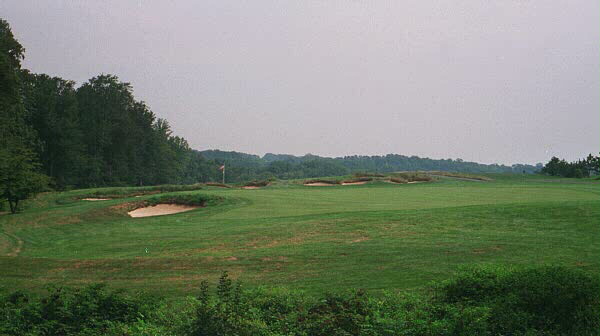
Twelfth hole, 470 yards; At the time, this was the architect’s favorite hole he had designed. It exemplifies ‘minimalist’ design. Tumbling landforms were incorporated into the fairway and the green, the flattest on the course, is protected only on one-side. The green site is essentially a field that – uncharacteristically for this period in design – goes wonderfully uncluttered by artificial mounds.
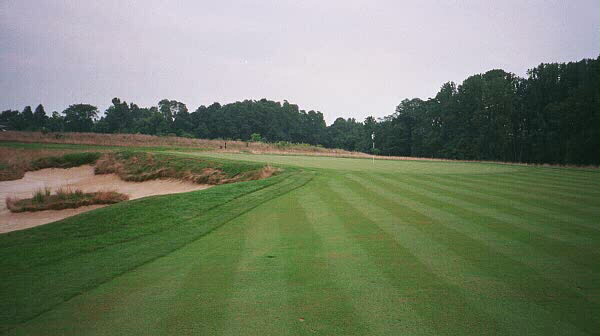
The course’s deepest bunker is short left and note how the putting surface is at grade with the fairway.
Thirteenth hole, 400 yards; Hanse professes his fondness for incorporating existing features into a hole, and the 13th highlights that up in spades. There is a sunken farm road cutting across the fairway diagonally from the left that forces the player either to lay back off the tee or to take on the bunkers on the right, which if he were in one he would have little chance of reaching the green. The multi-level green itself sits at an angle to the player in front of a white oak dating to 1643 (don’t ask how they determined the date!). The tree is as close to the green as agronomics would allow, and Hanse is to be commended for integrating the tree into the green site so well and for featuring both the road and the tree without making the hole looked forced.

This awkward stance is the result of a slightly pulled drive on the 13th, bringing the sunken road into play. The white oak dating from 1643 is behind the green.
Fourteenth hole,200 yards; A hole that aesthetically would fit in at Royal Melbourne with its sweeping bunkers on the left, the 14th actually involved more earth-movement than other holes. The pit to the right of the green was dug out, with the fill going to the green site. The large, rolling green is appropriate for a long-iron, and all the sand on the left has fooled more than one player into playing down the right, with worse results as he finds the rough hollow.
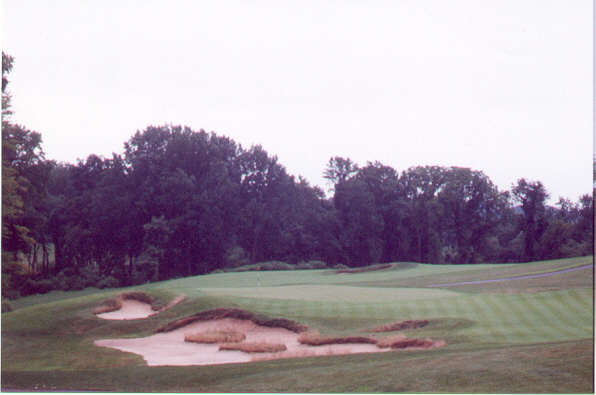
Melbourne or Philadelphia? The 14th at Inniscrone.
Fifteenth hole, 540 yards; While the authors wonder how necessary the Principal’s Nose bunker that bisects the drive zone is (i.e., there does not seem to be a great advantage gained by going to one side or the other), the last 50 yards of this hole is just terrific stuff. Starting with the diagonal cross bunkers some 75 yards out, the fairway runs down to the green, which itself is just an extension of the fairway running away from the player. The fairway will help the properly played shot find the green, but how precisely played that shot must be! Even for those laying up, this bunker line demands their full attention for the second shot – to play short or to the right. The challenge before the player is how to play boldly over the cross bunkers (whether with a second or third shot) to the narrow approach short of the green but with enough softness to keep the ball on the green.
Sixteenth hole, 385 yards; The 16th is the most dramatic hole at Inniscrone, and perhaps the one that required the most confidence and nerve to build. After a drive to a moderately narrow fairway, the player has a mid- to short-iron to a narrow, angled green cut into a right-to-left slope with a great drop-off left and a rough and bunker strewn chasm in front. There is another fairway to the right, on top of the hill, but it cannot be reached from the tee and offers little help for a safe second as the player would then be coming into the green from an undesirable angle, still needing to carry his third to the putting surface.

The demanding approach to the 16th.
No description of Inniscrone is complete without making reference to the controversial 5th, a 105-yard drop-shot hole to a wide but quite shallow green that runs away in spots and leads to a ten-foot drop behind the green. Its detractors point to the fact that it is all too possible for a crisply-struck pitch to land on the downslope on the front center part of the green and finish in the deep bunker beyond the green, leading to a score of 5 in many cases. However, it is interesting to hear a table full of golfers describe their strategies for the hole – some will deliberately play toward the front bunker and take their chances getting up and down, many will just play to the deeper and flatter right third of the green, while others have enough confidence in their accuracy and distance-control that they will go after the hole no matter where it is. To the authors, any hole that can generate such debate as to the best way to play it can’t be but so bad. Toss in the fact that the shot is only with a lob wedge or a small sand iron, and there just isn’t cause for calls of unfairness.
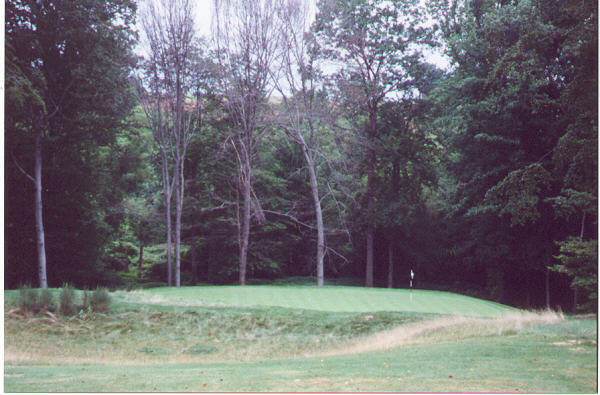
Much of the trouble is hidden from view on the short 5th.
In his January 2000 Feature Interview on this site, Hanse commented that someone whom he respects had told him that there are many features at Inniscrone he likes quite a bit but that in places it seemed Hanse had overdone things, trying to inject too many particular features into the course. In general, the authors believe the only part of the course that was perhaps ‘too much’ is the combination of the 16th and 17th holes, an intimidating 385 yarder with its approach across a valley to a narrow green and a 472 yarder around and across wetlands to a semi-punchbowl green that is damned hard to find with a long-iron, respectively. Each hole stands fine on its own, but, thrown together and located at that stage in the round, the golfer might feel a bit overwhelmed.
Also, largely due to the severe site and environmental restrictions, the course does not consistently provide an out or alternate route for the high-handicapper. There are several holes (8, 10, 16-18) where the high-handicapper has to work hard (and play well) to score a bogey; these holes can leave such players with the impression that Inniscrone is a multi-ball course. On a smaller scale, the authors think there are just a few too many bunkers with grass islands. A handful of such bunkers on a course is distinctive, but more than that and they begin to look like a cry for attention.
Overall, then, where does Inniscrone fit in the world of golf? As a refreshing and encouraging design that has an edge to it, thanks to some bold features from which many other architects would have shied away. However, its greatest attribute is that it succeeds where a private club should succeed – as a course that would be fascinating to play day after day, week after week, and year after year. There are several holes, such as with the approach to the 17th, where the player requires many attempts before settling on the best tactic (which could then change significantly depending on the hole location). Gil Hanse has gone on to achieve design greatness and this early work shows that we should have always seen it coming.
The End

